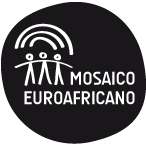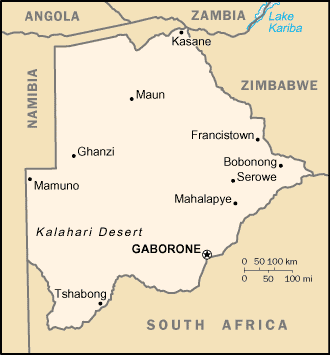BOTSWANA FAST FACTS
OFFICIAL NAME: Republic of Botswana
FORM OF GOVERNMENT: Parliamentary Republic
CAPITAL: Gaborone
POPULATION: 2,249,104
OFFICIAL LANGUAGE: English (Setswana is the most commonly spoken language)
MONEY: Pula
AREA: 224,607 square miles (581,730 square kilometers)
GEOGRAPHY
Botswana is a landlocked country in southern Africa. It is bordered by South Africa to the south and east, by Namibia to the west, and by Zimbabwe to the east. The massive Kalahari Desert covers more than 70 percent of Botswana, spans about 360,000 square miles (900,000 square kilometers), and touches nine African countries. The Kalahari isn’t a true desert because it gets more rainfall each year than most deserts receive. Because drought is a problem in Botswana, rain is precious. When rain comes, it’s sporadic and often causes flooding.
PEOPLE & CULTURE
Most of the people in Botswana are Tswana and are said to be descended from King Mogale who lived during the 14th century. The Tswana now live primarily in large cities and towns, but many also still live in villages and take care of livestock and grow food. The next two largest ethnic groups in Botswana are the Bushmen and the Kalanga. Only about one percent of the population is white from Europe or the United States. Children go to primary school for seven years and then on to secondary school for five years. They learn English in the fifth year of primary school onward, but not many people become fluent. The native language Setswana is also one of South Africa’s official languages.
GOVERNMENT
Botswana has been a stable democracy since it became independent in 1966. Every five years the people elect the members of the National Assembly and the assembly elects the president. The president can remain in office for ten years. In 2004, Botswana was named the least corrupt country in Africa by the World Economic Forum.
HISTORY
For centuries foreigners had control of much of Africa. The British and the Dutch (known as Afrikaners) fought to dominate the countries of southern Africa. In 1910, the countries to the south of today’s Botswana formed a Union of South Africa that was home to many white Afrikaners, British settlers, and the black majority. The white settlers controlled the laws and lives of the black South Africans. Botswana wanted to be free and independent from South Africa. Botswana eventually gained its independence from Britain in 1966. Sereste Khama was the country’s first president. In 1967, a huge area of diamonds was discovered at Orapa, at the edge of the Kalahari Desert. The economy grew very quickly with wealth from the diamond mines. Botswana is one of the world’s largest diamond producers.





